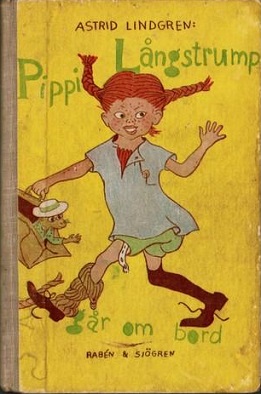Pippi Longstocking

Pippi Longstocking (Swedish: Pippi Långstrump) is the fictional main character in an eponymous series of children’s books by Swedish author Astrid Lindgren. Pippi was named by Lindgren’s daughter Karin, who asked her mother for a get-well story when she was off school.
Pippi is red-haired, freckled, unconventional and superhumanly strong – able to lift her horse one-handed. She is playful and unpredictable. She often makes fun of unreasonable adults, especially if they are pompous and condescending. Her anger comes out in extreme cases, such as when a man mistreats his horse. Pippi, like Peter Pan, does not want to grow up. She is the daughter of a buccaneer captain and has adventure stories to tell about that, too. Her four best friends are her horse and monkey, and the neighbours’ children, Tommy and Annika.
After being rejected by Bonnier Publishers in 1944, Lindgren’s first manuscript was accepted by Rabén and Sjögren. The three Pippi chapter books (Pippi Longstocking, Pippi Goes on Board, and Pippi in the South Seas) were published from 1945 to 1948, followed by three short stories and a number of picture book adaptations. They have been translated into 76 languages as of 2018[1] and made into several films and television series.
Pippi Longstocking is a nine-year-old girl.[2] At the start of the first novel, she moves into Villa Villekulla: the house she shares with her monkey, named Mr. Nilsson, and her horse that is not named in the novels but called Lilla Gubben (Little Old Man) in the movies.[3] Pippi soon befriends the two children living next door, Tommy and Annika Settergren.[4][5] With her suitcase of gold coins, Pippi maintains an independent lifestyle without her parents: her mother died soon after her birth; her father, Captain Ephraim Longstocking, goes missing at sea…ultimately turning up as king of a South Sea island.[6][7] Despite periodic attempts by village authorities to make her conform to cultural expectations of what a child’s life should be, Pippi happily lives free from social conventions.[8][9] According to Eva-Maria Metcalf, Pippi “loves her freckles and her tattered clothes; she makes not the slightest attempt to suppress her wild imagination, or to adopt good manners.”[9] Pippi also has a penchant for storytelling, which often takes the form of tall tales.[10]
When discussing Pippi, Astrid Lindgren explained that “Pippi represents my own childish longing for a person who has power but does not abuse it.”[11] Although she is the self-proclaimed “strongest girl in the world,” Pippi often uses nonviolence to solve conflicts or protect other children from bullying.[12][13] Pippi has been variously described by literary critics as “warm-hearted,”[8] compassionate,[14] kind,[15] clever,[7] generous,[8][16] playful,[17] and witty to the point of besting adult characters in conversation.[8] Laura Hoffeld wrote that while Pippi’s “naturalness entails selfishness, ignorance, and a marked propensity to lie,” the character “is simultaneously generous, quick and wise, and true to herself and others.”[18]
